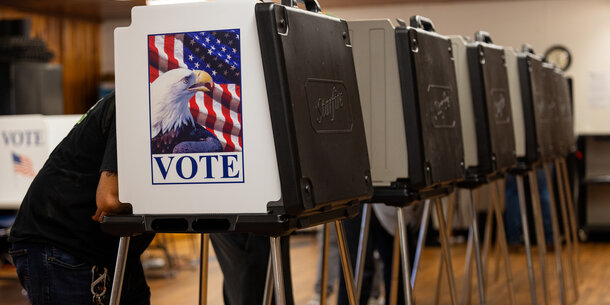On November 5, the Supreme Court will hear oral argument in a case testing the limits of presidential emergency powers. At issue is whether a president may use the International Emergency Economic Powers Act (IEEPA) to impose sweeping tariffs on imports from countries around the world.
The stakes of this case reach far beyond trade policy. The Court’s decision could shape whether the use of emergency powers to bypass Congress becomes a tool of routine governance, with profound implications for the constitutional separation of powers and limits on presidential authority.
The case arose after President Trump declared three national emergencies to impose tariffs on Canada, Mexico, and China, followed by a fourth national emergency to impose a 10 percent global tariff plus “reciprocal” tariffs of up to 50 percent on selected countries and corporations. He justified each of these measures as a response to an “unusual and extraordinary threat” to U.S. national security, foreign policy, and/or economy.
A number of corporations and states responded by filing suit in federal court. The Brennan Center has filed friend-of-the-court briefs in several of these cases, arguing that longstanding trade imbalances do not constitute an emergency or an “unusual and extraordinary threat” and that IEEPA does not authorize the president to impose tariffs. The Court will now determine whether the statute gives presidents a “tariff pen” that can bypass Congress entirely.
What is the International Emergency Economic Powers Act, and does it authorize tariffs?
IEEPA is one of 137 statutory powers that the president can invoke when he declares a national emergency under the National Emergencies Act. Both IEEPA and the National Emergencies Act were enacted in the 1970s after a series of scandals involving executive overreach. Their goal was to rein in presidential emergency powers, not expand them. They were designed to ensure that emergency powers would be used only in response to genuine threats rather than as a means to circumvent Congress when dealing with normal, ongoing problems.
Under IEEPA, a president may declare a national emergency and take specified measures, including “investigat[ing], regulat[ing], or prohibit[ing]” certain financial transactions, to deal with an “unusual and extraordinary threat, which has its source in whole or substantial part outside the United States, to the national security, foreign policy, or economy of the United States.”
Historically, presidents have used that authority to impose sanctions on hostile foreign actors: freezing the assets of international terrorist groups, restricting trade in arms or dangerous technologies, or blocking transactions with foreign governments or governmental officials. No president has ever interpreted the statute to authorize tariffs, let alone across-the-board tariffs on imports from friendly nations.
Tariffs are governed by a separate body of trade law, which includes certain limited powers to impose tariffs in response to national security threats or trade imbalances. The administration, however, contends that the word “regulate” in IEEPA is broad enough to include tariff measures — including ones that exceed what Congress has authorized in trade laws — and that courts should defer to the president’s national security judgment.
As all of the courts to issue decisions on the merits have found, this sprawling interpretation of the word “regulate” fails multiple tests that courts use for interpreting statutory text. The Court of International Trade went further, holding that interpreting the statute to permit Trump’s worldwide tariffs would render it an unconstitutional delegation of Congress’s tariffs power. And the Brennan Center’s friend-of-the-court brief provided yet another ground to reject the administration’s reading of the law: Interpreting it to grant powers not expressly provided would contravene the intent behind both the National Emergencies Act and IEEPA, namely, to rein in presidential use of emergency powers.
Why does this case matter for the separation of powers?
The Constitution assigns Congress — not the president — the power to “lay and collect duties” and to regulate foreign commerce. Over time, Congress has delegated parts of that authority to the executive through various laws that expressly authorize the imposition of tariffs under specific conditions, often with time limits or a ceiling on the amount of the tariffs. President Trump, however, is trying to bypass these laws and their carefully crafted limitations by declaring a national emergency and invoking a law, IEEPA, that does not even mention tariffs.
What’s more, the administration is arguing that courts cannot review whether an emergency exists or whether the condition for invoking IEEPA— the existence of an “unusual and extraordinary threat” — has been met. It is clear why the administration is demanding absolute deference from the courts. By no stretch of the imagination can long-standing trade relationships be considered an “emergency,” a term that refers to a sudden, unforeseen event. And there is nothing “unusual and extraordinary” about a “threat” posed by our trade relationships with nearly every country on earth.
If the Court upholds Trump’s use of IEEPA for tariffs, it could cement a broad precedent for governing by emergency. Future presidents could claim nonexistent emergencies to act unilaterally on any number of issues, from climate policy to technology regulation. (Trump himself has already declared nine national emergencies in his first nine months in office, far outpacing any other president since the enactment of the National Emergencies Act.)
Not only would presidents be able to act without congressional authorization — in many instances, they would be able to circumvent laws that would otherwise prohibit their actions. That would dramatically upset the balance of power between the president and Congress in almost every area in which Congress legislates.
How could the Supreme Court rule?
The Court should reject the administration’s assertion of unreviewable presidential authority and strike down the tariffs. There are several possible routes to that outcome. The Court could rule that there is no national emergency, that longstanding trade imbalances do not constitute an “unusual and extraordinary threat,” or that IEEPA simply doesn’t authorize tariffs, no matter the circumstances. Or the Court could more narrowly rule that the statute authorizes only targeted, proportionate measures tied directly to a specific foreign threat, not blanket tariffs applied globally.
Any of these approaches would reassert Congress’s primacy in trade policy. More generally, they would reaffirm the principle that a power as potent as the authority to impose global tariffs must be clearly authorized by statute.
On the other hand, the Court could side with Trump, holding that he has broad authority to declare a national emergency and impose tariffs based on a claim of economic threat. If the Court were to rule for the president — or even if it ruled against him on whether IEEPA covers tariffs, but agreed that courts cannot second-guess whether an “emergency” or “unusual and extraordinary threat” exists — that would create a dangerous precedent, inviting Trump and future presidents to use emergency powers as a way to circumvent Congress when pursuing their policy agendas.
***
If the president believes that global tariffs are in the national interest, he should take his case to Congress. Lawmakers can decide whether to adopt his plan via the regular legislative process, with democratic debate and accountability to their constituents. That is what the Constitution envisions, and it is the proper course of action here.





